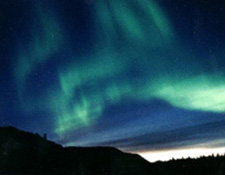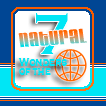|
 Northern lights or Aurora borealis brings together two mythological deities ‐ Aurora, the Roman goddess of the dawn, and Boreas, Greek god of the north wind ‐ to describe an event witnessed mostly at night in the high northerly latitudes. The flowing ribbons, sky‐filling swirls, otherworldly glow, gossamer veils, and brilliant rays of the aurora borealis are a regular presence that has awed and terrified northern peoples for thousands of years. To Finns the aurora was "fox fire" sparked by glistening fur. Some Alaskan Inuit saw the dancing souls of deer, seals, salmon, and beluga; others believed that if they whistled the lights might snatch them away. The Athabascan saw messages from their dead, the "sky dwellers." Northern lights or Aurora borealis brings together two mythological deities ‐ Aurora, the Roman goddess of the dawn, and Boreas, Greek god of the north wind ‐ to describe an event witnessed mostly at night in the high northerly latitudes. The flowing ribbons, sky‐filling swirls, otherworldly glow, gossamer veils, and brilliant rays of the aurora borealis are a regular presence that has awed and terrified northern peoples for thousands of years. To Finns the aurora was "fox fire" sparked by glistening fur. Some Alaskan Inuit saw the dancing souls of deer, seals, salmon, and beluga; others believed that if they whistled the lights might snatch them away. The Athabascan saw messages from their dead, the "sky dwellers."
For a long time, scientists offered almost as many interpretations of the northern lights as did the traditional peoples who observed them. The 20th century has brought with it studies of the earth's magnetism and the sun's workings. The aurora arises in the roiling turbulence of the sun. More than 100,000 times hotter than boiling water, the sun's interior chops the atoms that form solar gases into a thin stream of electrically charged particles ‐ protons and electrons. Both matter and energy, this stream continuously erupts from the sun and is called the solar wind. Two or three days after bursting from the sun's surface at speeds of up to 500 miles a second, the solar wind reaches the earth, 93 million miles away.
 Though most of the solar wind harmlessly sideswipes the magnetic shield, small streams of solar particles do manage to become trapped, spiraling down toward the planet's north and south magnetic poles. As they tumble, beams of electrons spread, ripple, and swirl, and yet their movements remain invisible. But when the solar wind hits the upper reaches of the ionosphere and encounters atmospheric gases, it starts churning the thin soup of oxygen and nitrogen there. Marvelous shapes and flowing patterns begin to appear. Electrons bouncing around among atoms of oxygen create a greenish glow much lower. Nitrogen molecules hit by solar wind may shine bright pink, or blue and violet, depending upon their distance from the surface. Though most of the solar wind harmlessly sideswipes the magnetic shield, small streams of solar particles do manage to become trapped, spiraling down toward the planet's north and south magnetic poles. As they tumble, beams of electrons spread, ripple, and swirl, and yet their movements remain invisible. But when the solar wind hits the upper reaches of the ionosphere and encounters atmospheric gases, it starts churning the thin soup of oxygen and nitrogen there. Marvelous shapes and flowing patterns begin to appear. Electrons bouncing around among atoms of oxygen create a greenish glow much lower. Nitrogen molecules hit by solar wind may shine bright pink, or blue and violet, depending upon their distance from the surface.
The ever changing dance of lights belies the aurora's permanence. Though only parts of it can be seen at any time, and almost never during the day, the aurora borealis forms a 2,000‐mile‐wide auroral oval above the magnetic north pole day in and day out, year after year.
|

